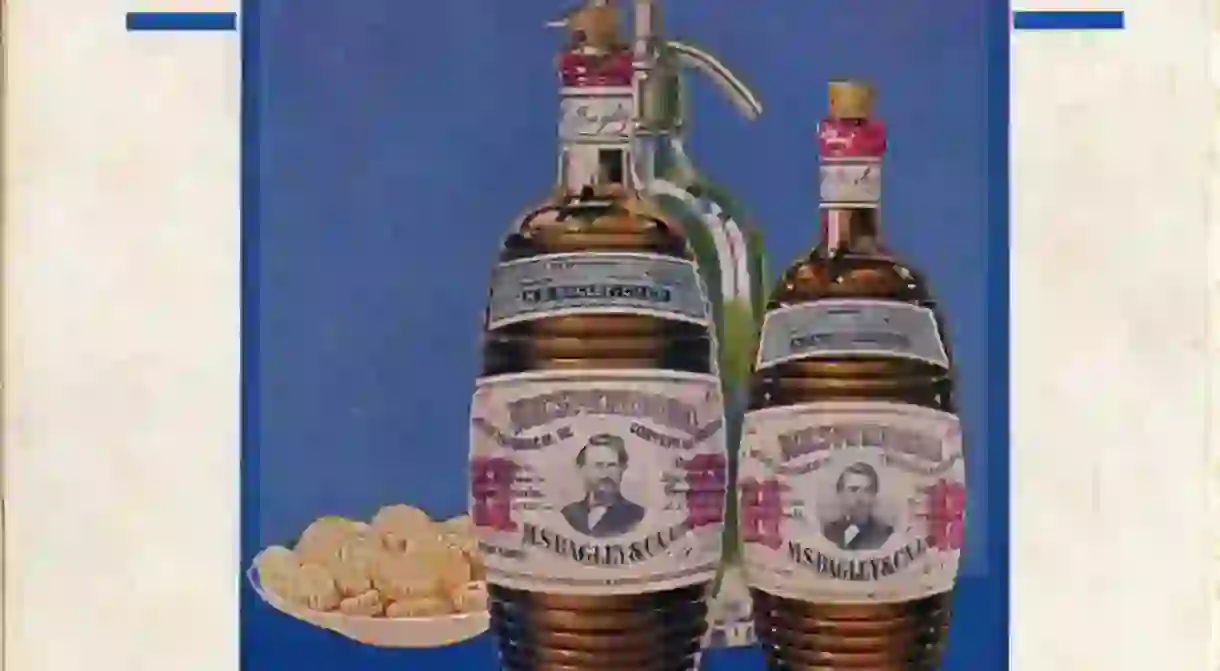The Strange Story of Hesperidina, Argentina's National Tipple

This aperitif, little-known outside Argentina, was made by a runaway from the American Civil War, and ended up being South America’s first mass-market phenomenon.
Nestled away at the back of every bartender’s shelf in Buenos Aires is an odd, beehive-shaped bottle, mostly untouched. This is Hesperidina, Argentina’s increasingly unfashionable national tipple, and depending on how friendly your server is, you could either get a measure of it over the rocks, or a stern rebuke for ordering an old man’s drink. “My granddad used to drink it with soda,” Sebastian Atienza, owner of the cocktail bar Tres Monos says, “it was what all their generation drank. That’s not the case anymore.”

It wasn’t always this way. There was a time when Hesperidina was the drink of the moment, an enigmatic brew of orange and mint with the power to heal all your ills. The drink was a public phenomenon, and remained a constant in the lives of urban Argentinians as Buenos Aires transformed around them into the cosmopolitan behemoth it is today. And it was created, through conscientious objection, by an American émigré called Melville Sewell Bagley.
Bagley, born in Maine but having been based in New Orleans, fled the US in 1861 to avoid conscription into the Union’s military with the outbreak of the American Civil War. Arriving by boat in the port city of Buenos Aires, he worked in Farmacia La Estrella – a grand, marbled pharmacy in the district of San Telmo, built to be the finest in the continent and still in business today. Noting the trend for health tonics that had existed in North America, Bagley set about developing his own curative elixir from the abundant bitter oranges in Argentina.

But he did not merely develop his liqueur and sell it through the pharmacy. Instead, he set about on an ingenious, bafflingly successful guerrilla marketing campaign, the likes of which would still be groundbreaking today. Working at night, he would paint walls with ‘HESPERIDINA’. He took out banner adverts in newspapers which stated, in black and white, ‘HESPERIDINA SE ACERCA’ (‘Hesperidina is coming’). He would even go along the streets pouring bottles and bottles of the liquor on to the sidewalk, so that passers-by would pick up the scent and be curious.
Inexplicably, this worked. The porteños of Buenos Aires took to Hesperidina immediately following the clamour, loving it not just for its taste, but for its healing properties. Bagley claimed, with the authority of every other tonic manufacturer of the time, that Hesperidina “stimulates and tones the nervous system; promotes healthy secretions of the body… [and is] a safe and pleasant remedy for dyspepsia, indigestion, constipation, colic diarrhea, dysentery, chlorosis, and nervous attacks of the stomach, intestines, head and heart.” The Argentine government were so taken with those claims that the military were ordered to drink one cup of Hesperidina a day as they fought the Paraguayans in the War of the Triple Alliance.

With success comes imitation, and bootleggers were hot on the heels of Bagley. He used his contacts in the now-peaceful United States to make unforgeable labels, and the iconic barrel bottle, crafted to ward off any competitors. The greatest – and yet least glamorous – innovation Bagley brought to Argentina, however, was patent law. Convincing the president of the need to defend his tonic’s unimpeachable status, Bagley established Hesperidina as Argentina’s first patent, and its marketing opened Argentina up to the flows of Western consumerism.
In its uproarious heyday, the early 50s, Argentines would get through 250,000 litres (440,000 pints) of Hesperidina a month, sinking it back with soda or on ice at tango clubs as they prospered under Juan Peron. Such was its ubiquity in the dance halls, that there was even a tango written for it – Hesperidina: Tango de Moda. But those salad days are long gone for Hesperidina; until recently, when the city’s bartenders reclaimed this storied tipple for the modern age.

“It’s a beautiful product,” Atienza says. “It has such an amazing history, and is so versatile. As a bartender, I feel like I have a responsibility to show people what it can do.” At Tres Monos, Atienza makes use of Hesperidina as he would Cointreau – although it is a fair bit lighter than Cointreau – mixing it in with whiskey and ginger ale to bring its floral orange notes to the forefront. If you stick around long enough, he’s been known to serve it out in shot form, tipped into a clamshell, for you to try while he recounts the drink’s strange, beguiling history, and its place in Argentine culture.
For more information on tours, attractions and Buenos Aires as a visitor destination, visit their tourist board website.













